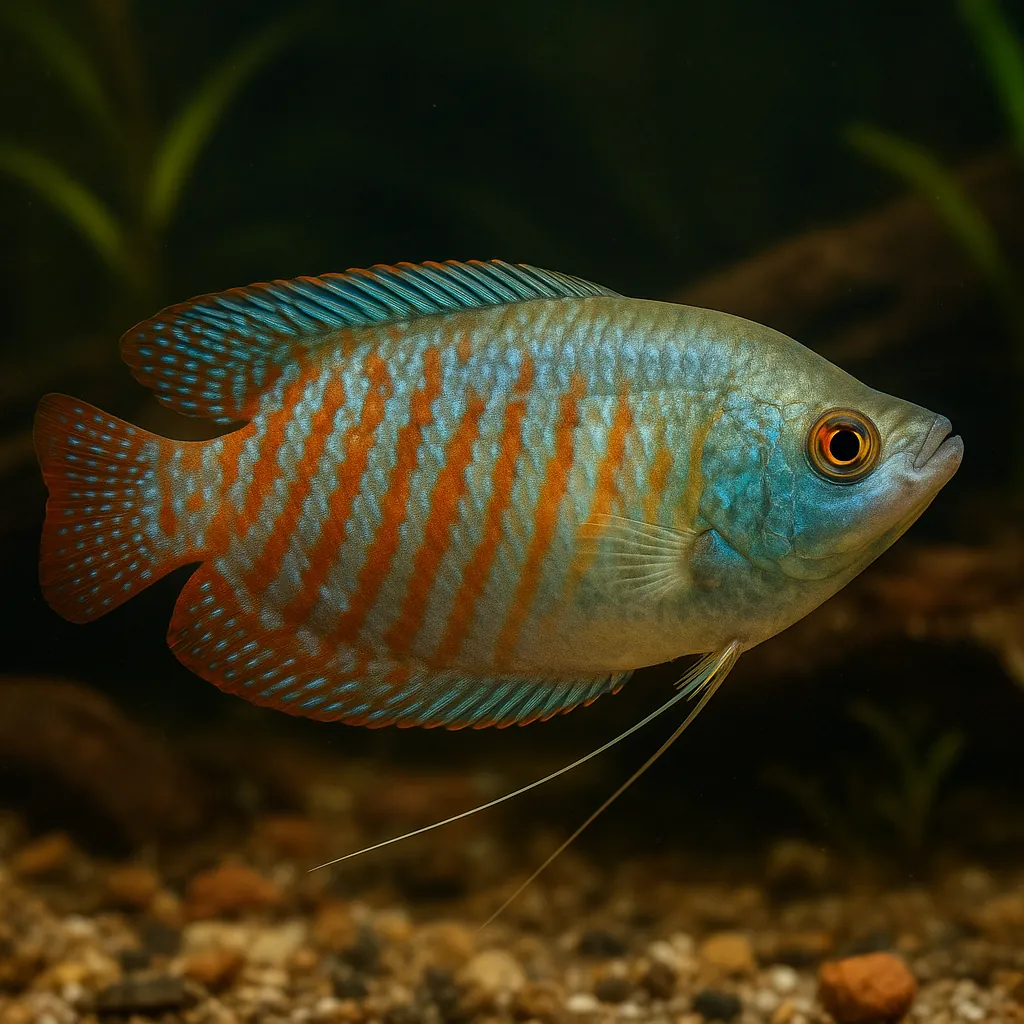
Dwarf gourami
Introduction
The Dwarf Gourami (Trichogaster lalius) is a vibrant and popular freshwater fish among aquarists. Known for their striking colors and peaceful demeanor, these small labyrinth fish are well-suited for community tanks. Their manageable size and relatively straightforward care requirements make them an excellent choice for both novice and experienced fishkeepers.
What makes Dwarf Gouramis appealing to aquarists?
Their vivid coloration, ranging from bright blues to deep reds, adds a splash of color to any aquarium. Additionally, their calm nature allows them to coexist harmoniously with a variety of tank mates.
Are Dwarf Gouramis suitable for beginners?
Yes, their hardy nature and adaptability to various water conditions make them ideal for those new to fishkeeping.
Care and Environment
Proper care and a well-maintained environment are crucial for the health and longevity of Dwarf Gouramis. Here's a comprehensive guide to their care:
What is the minimum tank size for a Dwarf Gourami?
A single Dwarf Gourami requires a minimum tank size of 38 liters (10 gallons). However, providing a larger tank is beneficial, especially if you plan to keep multiple fish or a community setup.
What are the ideal water parameters for Dwarf Gouramis?
Maintain a temperature between 22°C and 28°C (72°F to 82°F), a pH level of 6.0 to 7.5, and water hardness between 4 and 10 dGH. Consistent water quality is vital, so regular monitoring and maintenance are recommended.
How should the tank be set up for Dwarf Gouramis?
These fish thrive in tanks with dense vegetation, including floating plants like hornwort, which provide cover and mimic their natural habitat. A gentle filtration system is preferred to avoid strong currents, as Dwarf Gouramis are accustomed to slow-moving waters. Subdued lighting and a dark substrate can help them feel more secure.
What should I feed my Dwarf Gourami?
As omnivores, they enjoy a varied diet. High-quality flake or pellet food should be the staple, supplemented with live or frozen foods such as brine shrimp or bloodworms to enhance their coloration and health.
Are there any specific challenges in keeping Dwarf Gouramis?
While generally hardy, they can be sensitive to poor water quality and are susceptible to diseases like the Dwarf Gourami Iridovirus. Regular water changes and monitoring for signs of illness are essential. Additionally, males can become territorial, especially during breeding, so providing ample hiding spots and monitoring their behavior is important.
Origin and Habitat
Dwarf Gouramis are native to South Asia, particularly in countries like India, Pakistan, and Bangladesh. They inhabit slow-moving rivers, streams, and lakes with abundant vegetation. These environments are characterized by warm temperatures and soft, slightly acidic to neutral water. The dense plant life provides shelter and breeding grounds, while the slow currents align with their preference for calm waters.
How does their natural habitat influence their care in aquariums?
Replicating their natural environment by providing a well-planted tank with gentle water flow helps reduce stress and promotes natural behaviors.
Do Dwarf Gouramis require specific water conditions?
Yes, maintaining water parameters that mimic their native habitat—such as appropriate temperature, pH, and hardness—is crucial for their well-being.
Temperament and Compatibility
Dwarf Gouramis are generally peaceful and can be excellent additions to community tanks. However, understanding their behavior is key to ensuring harmony.
Are Dwarf Gouramis aggressive?
While they are typically peaceful, males can exhibit territorial behavior, especially during breeding. It's advisable to keep only one male per tank unless the aquarium is large enough to establish separate territories.
What are suitable tank mates for Dwarf Gouramis?
Compatible tank mates include small, non-aggressive species such as tetras, rasboras, mollies, and bottom dwellers like Corydoras catfish. Avoid housing them with aggressive or fin-nipping species to prevent stress and injury.
Can Dwarf Gouramis be kept together?
Yes, but it's best to maintain a ratio of one male to multiple females to reduce aggression. Providing ample hiding spots and space can also help minimize territorial disputes.
Interesting Facts
Dwarf Gouramis possess several fascinating traits that endear them to aquarists.
Do Dwarf Gouramis have any unique behaviors?
Yes, they are labyrinth fish, meaning they have a specialized organ that allows them to breathe atmospheric air. This adaptation enables them to survive in low-oxygen environments by gulping air at the water's surface.
How do Dwarf Gouramis reproduce?
Males construct elaborate bubble nests at the water's surface using plant materials and bubbles. After the female lays eggs in the nest, the male guards them until they hatch, showcasing their dedicated parental care.
Are there different color varieties of Dwarf Gouramis?
Yes, selective breeding has produced various color morphs, including powder blue, flame red, and neon blue, offering aquarists a range of vibrant options.
Sources
All information in this article has been gathered from the following reputable sources:
Overview
Recommended Tank Size 15.1 Gallons (for a pair or small group) |
Minimum Group Size 1 |
Minimum Tank Volume 10 Gallons |
Maximum Adult Length 3 inches |
Average Adult Length 2.6 inches |
Shoaling (6+ required) No |
Preferred Water Type Freshwater, soft to moderately hard, slightly acidic to neutral |
Temperature Range (°C) 22–28 |
pH Range 6.0–7.5 |
Water Hardness (dGH) 4–10 |
Typical Lifespan (years) 4 years |